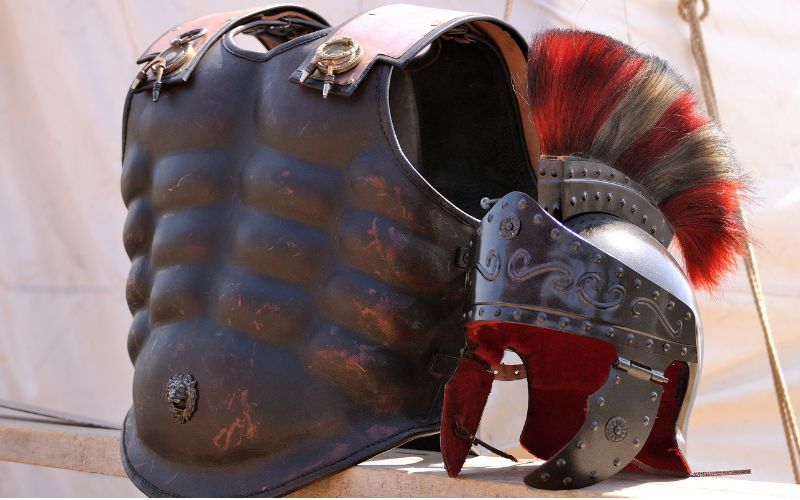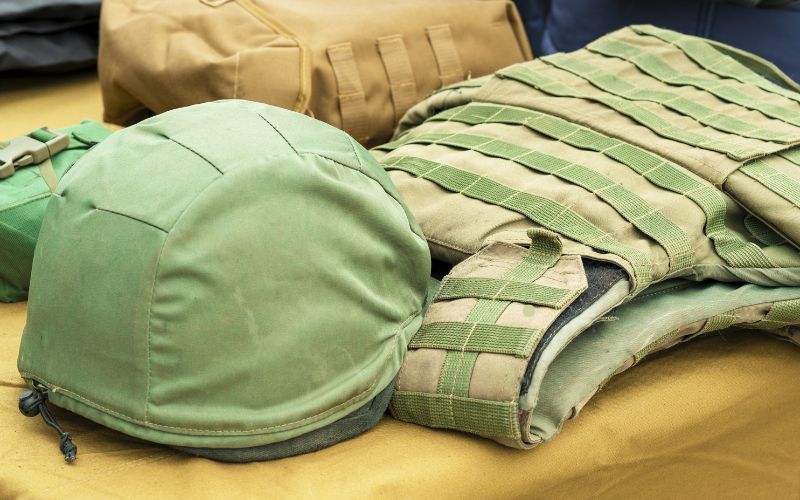How Does Steel Body Armor Compare to Other Materials?

When you think about body armor, steel often stands out for its reliable protection and durability, especially against rifle rounds. However, it is important to weigh its heft and rigidity against other materials like ceramic and polyethylene. Unlike steel, ceramic armor offers lighter weight and flexibility but doesn’t handle multiple hits. Polyethylene, while extremely lightweight and mobile, trades off some durability and stopping power. How do these differences impact your choice for high-threat scenarios? Let’s explore the nuances of each material to understand which might suit your needs best.
Key Takeaways
- Steel body armor offers superior rifle-rated protection but is significantly heavier than ceramic and polyethylene alternatives.
- Steel plates provide excellent durability and can withstand multiple hits, outlasting ceramic and polyethylene in longevity.
- Ceramic armor is 37% lighter than steel, enhancing mobility and flexibility in tactical situations.
- Polyethylene armor is the lightest option, reducing fatigue and improving speed, but it lacks the durability of steel.
- Steel body armor is cost-effective and has a long shelf life of up to 20 years, which makes it ideal for prolonged use.
Advantages of Steel Body Armor

Steel body armor stands out for providing reliable rifle-rated protection against high-velocity threats. One of its primary advantages is its excellent, all-encompassing protection. Steel plates can withstand multiple hits from rifle rounds such as 7.62×51 M80 Ball and 5.56 M855/SS109 without losing their effectiveness, making steel armor a solid choice for sustained fire scenarios.
Moreover, steel body armor is rated to the NIJ level III standard, guaranteeing it meets rigorous testing and performance criteria. Another significant benefit is the long shelf life; steel armor can last up to 20 years, offering cost-effective long-term protection. Its resistance to cracks, degradation, and extreme temperatures further enhances this durability, making it a reliable option in various conditions.
While steel body armor may be less comfortable to wear than other materials, its edge-to-edge protection ensures comprehensive coverage. Despite its heavier weight, the advantage of steel body armor lies in its robust and consistent performance across multiple threats.
Steel body armor is worth considering if you’re looking for an affordable yet highly durable solution.
Limitations of Steel Body Armor
One major limitation of steel body armor is its weight, which can hinder mobility and cause fatigue during extended wear. Steel plates weigh 7-8 lbs. each, making them noticeably heavier than ceramic or polyethylene alternatives. This additional weight and bulk can restrict movement, making it challenging to perform tasks that require agility and quick reflexes.
Flexibility concerns further complicate the use of steel body armor. Unlike ceramic or polyethylene, steel doesn’t conform to your body, leading to discomfort and a reduced range of motion. This can be particularly problematic in dynamic environments where full mobility is vital.
Another critical issue is spall and fragmentation. When steel armor takes a hit, it can produce dangerous fragments that might injure you or others nearby. Additional coatings and padding are necessary to mitigate this, adding more weight and bulk.
The limitations of steel body armor don’t end there. The added layers required for comfort and safety exacerbate the impact on mobility, making it harder to move swiftly and efficiently. All these factors combined make steel less appealing when compared to lighter, more flexible materials like ceramic.
Steel Vs. Ceramic Armor

When comparing steel and ceramic armor, it’s important to weigh the trade-offs between weight, durability, and overall protection. Steel body armor offers rifle-rated protection starting at Level III, adhering to NIJ standards for ballistic protection. It’s known for its strength and durability and can withstand multiple hits from high-velocity rifle rounds. However, Steel armor is heavier and can affect mobility and comfort.
On the other hand, Ceramic body armor, including ceramic plates, is notably lighter—about 37% less than steel. This reduction in weight translates to better mobility and comfort, which can be vital in high-stress situations. Ceramic armor meets Level IV NIJ standards, providing higher ballistic protection against armor-piercing rounds. It shatters upon impact to disperse energy, but this also means it’s more fragile and less durable over time.
Steel vs. ceramic armor also involves cost. Steel armor is generally more cost-effective and has a longer shelf life of 15-20 years, compared to ceramic plates, which last 5-7 years.
Steel Vs. Polyethylene Armor
Frequently, you’ll find that polyethylene armor provides a lightweight alternative to the heavier steel options, enhancing your mobility in critical situations. If you’re seeking body armor that prioritizes agility, polyethylene might be your go-to choice. Its lighter weight greatly boosts your movement capabilities, which can be important during essential situations.
However, steel armor often outperforms polyethylene in terms of durability and multi-hit capability. Steel body armor is renowned for its long shelf life, up to 20 years, and ability to handle multiple ballistic impacts without compromising protection. This makes steel an appealing option if you want something durable and cost-effective.
Polyethylene armor, on the other hand, excels at trapping bullets upon impact, providing effective ballistic protection. Though less durable than steel, polyethylene’s design focuses on stopping power while maintaining a lighter weight.
In terms of rifle-rated protection, steel armor generally has the upper hand. It’s known for its robust defense against high-caliber threats.
Meanwhile, polyethylene armor offers great protection but emphasizes weight and mobility. Choosing between these armor materials depends on your safety, weight, and movement needs.
Weight and Flexibility
When you compare steel body armor to ceramic options, you’ll notice steel is considerably heavier, which can be a burden during long missions.
This extra weight also affects your flexibility, making it harder to move quickly and comfortably.
However, the distribution of this weight varies by material, impacting your overall mobility and endurance.
Steel Vs. Ceramic Weight
Although steel and ceramic body armor offer protection, the significant weight difference between them greatly impacts flexibility and mobility for the wearer. When you compare steel vs. ceramic weight, you’ll find that steel body armor weighs around 7-8 pounds per plate, whereas ceramic armor is approximately 37% lighter. This weight comparison is important because the heavier weight of steel armor can hinder your mobility, making it less suitable for situations requiring quick movements.
| Aspect | Steel Body Armor | Ceramic Armor |
| Weight per Plate | 7-8 pounds | 37% lighter |
| Ballistic Protection | High | High |
| Mobility | Limited | Enhanced |
| Durability | Excellent | Good |
| Operational Needs | High-threat scenarios | Quick, agile movements |
Both materials can stop high-velocity rifle rounds in terms of ballistic protection. However, steel’s durability makes it more effective against repeated hits. On the other hand, ceramic armor excels in flexibility and ease of movement, making it a better choice for operational needs that require agility. Understanding these trade-offs helps you decide which type of armor best suits your needs, balancing protection and mobility.
Flexibility in Movement
Steel body armor’s significant weight can drastically limit your flexibility and movement, making it less ideal for tasks requiring agility. Each steel plate typically weighs around 7-8 lbs., which can quickly add up and strain your body. This extra weight can restrict your flexibility and mobility, making it challenging to perform quick or prolonged actions.
In contrast, the lightweight nature of UHMWPE (Ultra-High-Molecular-Weight Polyethylene) makes it a more flexible option, allowing you to move more easily.
The weight and rigidity of steel armor often lead to reduced comfort, especially during extended wear. You might find yourself experiencing fatigue more quickly, which can be a significant drawback in situations where agility and quick responses are critical. However, steel armor’s exceptional protection is a trade-off many consider worth it. Customization of the plate fit can help mitigate some of the restrictions in movement, enhancing overall comfort and usability.
When evaluating steel vs. UHMWPE, you must balance steel’s superior protection with its increased weight and reduced flexibility. UHMWPE often provides a better balance between security and freedom of movement for operations requiring high mobility and comfort.
Material Weight Distribution
Understanding the impact of material weight distribution is key to evaluating the balance between protection and flexibility in body armor. Steel body armor, for instance, typically weighs around 7-8 lbs. per plate. This significant weight can affect mobility and comfort, especially during prolonged use.
In contrast, ceramic plates are approximately 37% lighter than steel, offering a better balance between weight and flexibility. This makes ceramic plates more suitable for situations where you need to move quickly and efficiently. Polyethylene armor, such as UHMWPE, takes it further by being even lighter than ceramic, vastly improving your mobility and reducing fatigue during extended operations.
Here’s a quick material comparison to illustrate these points:
| Material | Weight Per Plate | Flexibility | Wearability |
| Steel Body Armor | 7-8 lbs | Low | Moderate |
| Ceramic Plates | ~4.4-5 lbs | Moderate | High |
| Polyethylene Armor | Varies, < 4 lbs | High | Very High |
Cost and Durability
Why choose steel body armor when you need cost-effective, long-lasting protection? Steel vs ceramic armor is often an important consideration for anyone in high-risk professions. Steel body armor stands out as a budget-friendly option without sacrificing reliability. Its cost-effective nature makes it a practical investment for those who need durable protective gear.
One of the biggest advantages of steel armor is its long-term durability. With a shelf life of up to 20 years, it far outlasts many other materials, making it ideal for long-term use. Unlike ceramic plates, steel can withstand multiple hits without compromising its protective capabilities. This exceptional strength provides peace of mind, especially in high-risk scenarios.
Despite being heavier, steel’s durability makes it a top choice for military and law enforcement personnel who require consistent, reliable protection. Proper coating and padding can also mitigate spall and fragmentation risks, enhancing the effectiveness of steel armor.
Conclusion
Steel body armor is heavier and less flexible than other materials. However, its durability and ability to withstand multiple rifle hits make it a top choice for high-threat situations. Steel outlasts ceramic in durability and offers more reliable protection than polyethylene. Although it might weigh you down, its cost-effectiveness and reliable performance can’t be beaten. Steel body armor is superior when you need dependable, long-lasting defense.
Frequently Asked Questions
Is Steel Body Armor Any Good?
Yes, steel body armor is good due to its durability, bullet resistance, and cost-effectiveness. However, consider weight, heat retention, and maintenance requirements. It offers long-term usage but has lower comfort levels and potential corrosion issues.
What Are the Disadvantages of Steel Armor?
Steel armor has weight issues and comfort problems. It also has flexibility limitations, limited mobility, and heat retention. Spalling concerns, bullet ricochet, impact trauma, rust susceptibility, and corrosion risk are other significant disadvantages you should consider.
What Is Better Than Steel Armor?
Ceramic plates, Kevlar vests, and ultra-high-molecular Polyethylene plates might be better than steel armor for their light weight and flexibility. Composite armor, Titanium armor, Boron carbide, Aluminum alloy, and Graphene sheets offer advanced protection.
What Is the Best Material for Body Armor Plates?
When choosing the best material for body armor plates, consider ceramic composites, titanium alloys, and polyethylene plates. Evaluate material costs, weight considerations, durability factors, ballistic protection, and market trends to find the ideal Kevlar alternative.
